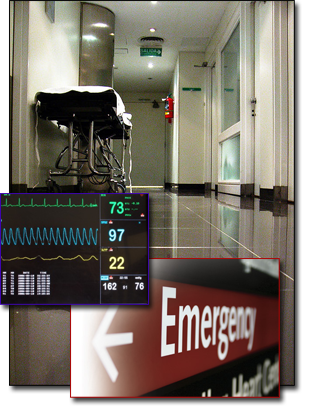Diagnosis
(Page 4)
The Emergency Room
When we arrived at Lions Gate Hospital it was just after 9:00pm.
There were several people ahead of us, but we were processed immediately once I disclosed my symptoms to the in-patient nurse. Within minutes I was moved around the corner to a room where the nurses began hovering over me, drawing blood, asking numerous questions about my condition, and eventually giving me a shot of nitro glycerin (in the form of a nasal spray) to dilate my blood vessels and lower my blood pressure. Yes, it was the same nitro glycerin that explodes like dynamite. As it turns out, in small amounts it saves lives — in larger amounts, not so much!

As I patiently waited for the results and the emergency room doctor, I was eventually told I would remain there for at least six more hours. One of the critical tests they were waiting for was my Troponin levels. Troponin tests are ordered for people who have experienced chest pains, possibly indicating heart damage or a heart attack. My first set of results came back negative, but just to be sure, they drew my blood again after six hours to verify. It takes several hours for the Troponin proteins to be released into the blood stream, and this time the test came back positive.
I was told they retested both samples again, but the conclusion was the same — my Troponin level was at 2.9, indicating a minor heart attack.

Over the years I saw many heart attacks on television — whether it be actors on a television program, or the media discussing its side effects — but to have personally experience one was an eye opener. I always thought heart attacks come only in one form — the critical one. You know, the one where the person collapses, everyone rushes in to help, and they either survive or die. All I experienced was a little shortness of breath, arm tingling, and some heart palpitations. But as much as I wanted to dismiss the symptoms, it was now clear there was something wrong and I was not leaving the hospital until it was resolved.

After few hours in the emergency room, I was moved to a bed in the Lions Gate Hospital Cardiac Arrest Ward where I would spend the next ten days. And that was when I decided to do some research, stay productive, and dig deeper into the medical terminology and my cardiovascular condition.
During the first few days, it was widely believed that my condition would inevitably follow the path of my father — coronary stenosis that called for angioplasty. Of course, all this was just speculation even after the echocardiogram and electrocardiogram results. What everyone was waiting for was an angiogram to definitively conclude my artery condition, and thus dictate what the next course of action would be.